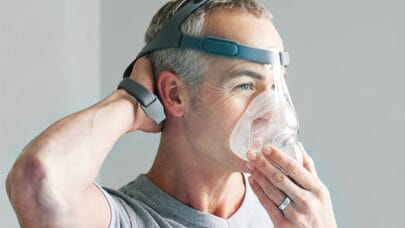
APAP Side Effects: Are They Different from CPAP?
If you are managing your sleep apnea symptoms, you may have opted to use an automatic positive airway pressure (APAP) device. Unlike CPAP machines, which deliver a fixed pressure, APAP adjusts airflow in real-time based on your breathing patterns to provide a more flexible and personalized treatment option. However, like any therapy, using an APAP device can come with side effects. Learn more about the potential challenges of using APAP, how they differ from CPAP side effects, and what you can do to address them.
Common APAP Side Effects
Dry Mouth or Throat
APAP users often report waking up with a dry mouth or throat. This can happen if you breathe with your mouth open while sleeping, even if you use a nasal mask. Low humidity settings on your APAP device may also be behind this type of discomfort.
How to Address It:
- Consider skipping a nasal mask and opting for a full-face version instead, which accommodates mouth breathing.
- Add heat to your therapy by adjusting the humidification settings on your APAP device. Most newer devices allow you to set the temperature of the air that is delivered to you through your mask.
Nasal Congestion or Irritation
The airflow from an APAP device can cause nasal dryness or congestion, especially for first-time users. This can interfere with your comfort during therapy and disrupt your sleep.
How to Address It:
- Use a heated humidifier attachment with your APAP device.
- Consider using a saline spray before bed to keep nasal passages moist.
Air Swallowing (Aerophagia)
Some users may experience a condition called aerophagia, which involves air entering the stomach while using your APAP. This can result in bloating, gas or abdominal discomfort.
How to Address It:
- Prevent air leaks by ensuring you have a correctly fitting mask.
- Consider adjusting your device’s pressure settings, which should be done with the guidance of your doctor or a sleep specialist.
Skin Irritation or Pressure Sores
The mask and headgear used with APAP machines can sometimes cause skin irritation or pressure sores. This issue is more common when you are wearing an ill-fitting or overly tight mask.
How to Address It:
- Choose a mask with adjustable straps for a personalized fit.
- Use mask liners or cushions to reduce friction and pressure.
Difficulty Adjusting to Variable Pressure
Unlike CPAP, which delivers constant pressure, APAP devices are able to provide variable airflow throughout the night. Some users may find this change in pressure distracting or uncomfortable during sleep.
How to Address It:
- Give yourself a grace period of time to adapt to the device’s functionality.
- Experiment with ramp settings, which gradually increase pressure as you fall asleep.
How Do APAP Side Effects Compare to CPAP?
Since both APAP and CPAP are designed to deliver pressured air, many side effects are shared between the two. On the one hand, the flexibility of APAP can help to minimize over- or under-pressure issues, which are a typical concern with fixed-pressure CPAP devices. On the other hand, however, the real-time adjustments in APAP therapy may present unique challenges, such as difficulty adapting to changing pressure levels. Most patients adapt well to APAP therapy as the changes in pressure make breathing easier. The device reacts to snoring and apneas with a subtle change in pressure, allowing you to sleep uninterrupted.
Tips for Reducing APAP Side Effects
If you’re having issues with your APAP device or are struggling with compliance, don’t stick with the discomfort. Here are some proactive steps that can help to improve your therapy:
- Invest in the Right Mask: The comfort of your therapy is significantly influenced by your mask choice. Full-face masks, nasal masks, and nasal pillows each cater to different needs, so spend some time experimenting to find your perfect fit.
- Optimize Humidification Settings: Heated humidifiers are commonly used to help alleviate issues like dry mouth and nasal irritation. Experiment with humidity levels to find what works best for you.
- Speak to an Expert: If you find you have ongoing side effects, consult your device provider, doctor or sleep specialist. They can adjust your APAP settings or recommend additional solutions, such as using chin straps for mouth breathing.
- Ensure Regular Machine Maintenance: It is essential to keep your sleep apnea equipment clean, as dirty or poorly maintained equipment can aggravate or cause side effects. Clean your mask, tubing, and filters regularly to prevent irritation or infection.
- Experiment with Ramp Features: If you are not comfortable using APAP’s variable pressure settings, enable the ramp feature on your APAP machine. This allows pressure to build up gradually, giving you time to fall asleep comfortably.
Why APAP May Still Be the Best Option
Despite any side effects you may experience, APAP devices are still thought to provide significant advantages ahead of CPAP for many users. The automatic adjustments help guarantee you the appropriate amount of airflow throughout the night, helping to improve the efficacy of your therapy. APAP can also accommodate changing needs more readily, including congestion, alcohol, or changes in your sleeping position.
Remember, 80% of the night is spent in non-REM sleep, requiring lower pressures. Only 20 to 25% of the night is spent in REM sleep where higher pressures are required.
If you’re experiencing APAP side effects, don’t hesitate to explore adjustments to your equipment or settings. The guidance of a sleep specialist can ensure you are maximising the benefits of your APAP device for restful, uninterrupted sleep.



